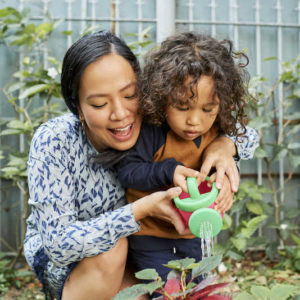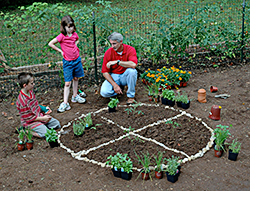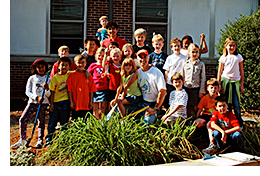
SuperKids Nutrition spoke with the seasoned gardener and television garden host, Joe Lamp’l, the Joe behind “joe
gardener“®.
We spoke with him about his garden philosophy, tips and insights into gardening with kids and helping your garden grow.
How to Introduce Kids to Gardening
Q: What is one simple step parents can do to introduce their kids to gardening?
Make it easy by starting with seeds so kids can see them grow. They’ll be amazed. It’s easy to hook them in when they take ownership. You can start with a little plot of land or a few pots. But get them involved early in the process.

When you start seedlings you can use a kit, yogurt cup or any small pot. Just be sure that whatever you use has a hole for drainage. Seed and plants can rot if the soil stays too wet. Bring them indoors and keep them by a window. Kids will love monitoring them before they go to bed each night and when they wake up first thing in the morning. It’s good to start seedlings inside early in the season since it’s too cold to start growing warm season plants outside in colder months. But, if you wait until after the last expected frost date in your area, you can plant directly outside instead, if you prefer. Check out my garden blog to help get you started.
Why Gardening is Important for Kids
Q: Why is having a garden important for children? Can you share with us three lessons that can be learned through gardening?
- Enjoying the outdoors: Getting outside and appreciating nature is good for the body, soul, and mind!
- Enjoying the freshest foods: A newly harvested cucumber just tastes so much better than a store bought one! Kids notice the taste difference and they like it -it’s surprising.
- Learning about life and education:
- Kids are fascinated with nature -they learn about bees, bugs, insects, and pollination.
- There are many life parallels to gardening that provide an opportunity to talk with your child about real issues, growing pains and concerns. Garden helps facilitate these discussions.
- Through gardening, they enjoy the fruits of their labor. They also experience trials and tribulations, successes and disappointments and overcoming adversity.
- Education:
- Opportunities to teach math through measurements -spacing required between plants, days to sprout, days to harvest etc.
- Science -teaching about the senses, order, and categories such as fungi, root, color, or compound categories.
- Art -creative arrangement and beauty
- Health -how proper care and nutrition (sun, water, and air) help grow a healthy plant
- For more garden learning with children,
Super Kids Nutrition recommends these links:
- Kids are fascinated with nature -they learn about bees, bugs, insects, and pollination.
Safe Materials for a Raised Food Bed
Q: We’ve heard that some woods and plastics can leach chemicals into the ground. What are safe materials families can use to build a raised platform?
 Use untreated wood. The older pressure treated wood has chemicals, the newer version has fewer offenders but still contain substances you would not want to eat. Cedar is fairly weather resistant. However, if you have a plot of land, you can simply break up the soil and start there. Although a platform garden is convenient, don’t let it delay getting started. An in-ground garden can be started right away, without too much work. Just make sure that you take the time to amend the soil to assure good drainage. That’s essential.
Use untreated wood. The older pressure treated wood has chemicals, the newer version has fewer offenders but still contain substances you would not want to eat. Cedar is fairly weather resistant. However, if you have a plot of land, you can simply break up the soil and start there. Although a platform garden is convenient, don’t let it delay getting started. An in-ground garden can be started right away, without too much work. Just make sure that you take the time to amend the soil to assure good drainage. That’s essential.
Herbs Kids Can Plant
Q: What are 3 herbs that kids can easily plant and care for?
The best aspect of herbs is once you see leaves you can eat them. So the fruits of your labor are quicker. Kids like the more immediate results and enjoy picking them without having to be as delicate.
- Basil and thyme are great and you can plant spinach, lettuce, beets, radishes and any number of other edibles right alongside these herbs. It’s a great way to
maximize the growing space in your garden. Kids like basil on pizza and in pesto sauces.- When you trim the basil, start with a large bunch and move down the main stem to an intersection and snip off the top. It will re-bud. You can also cut some off and put it in a glass of water near a window and watch it grow roots. Then you can replant it.
- For thyme, it’s pretty tough and can take the abuse of young gardeners! And it’s such a flavorful herb for many dishes. A little goes a long way.
- Rosemary is very hardy too. It grows all year in many parts of the country so it’s a great plant for year-round use in the kitchen.
Gardening With Limited Outdoor Space
Q: For families who want a garden but have limited outdoor space, what kind of advice can you offer?
Use a nice big container. For a family activity, you can decorate the outside by coloring or painting your favorite fruits and vegetables. Be sure to have good drainage from the pot and good soil. Try using container mix or potting soil, which are readily available at any garden center and are labeled accordingly. Involve your child in choosing which foods to plant. You can offer a few choices that you know will work for the space and sunlight you have available.
Vegetables that Grow Quickly
Q: Which vegetables have quicker growing times?
With younger children, it helps keep their interest if they can include a couple of plants with faster results.
- Lettuce and spinach grow quickly. You can eat them within 2-4 weeks of ‘germination’ if you want to enjoy them as microgreens. Otherwise, let them grow and harvest any time you’re ready. They’re great for garnish too. Use scissors to cut off what you need and it will continue to grow new leaves.
- Squash also grows fast! There are many types of squash, from zucchini to crookneck or yellow or green summer squash. Give it room to have enough air circulation. Don’t water the leaves; instead water at the base of the plant to help avoid mildew. Soaker hoses are great because they direct water at the base of the plant. It’s important for squash to have enough air circulation and light for optimal health.
- Lemon or round cucumbers are also delicious and a hit with kids. My children actually ate these over sweets last summer. There are great varieties of cucumbers
that kids will like, such as lemon and green fingers. They are easy to grow too. - Carrots and radishes are great. In fact, radishes are the fastest growing edibles in the garden from seed to full maturity at around 29 days. Don’t forget they come in a variety of colors -yellow, red, purple and white. Your children may like a vegetable you don’t prefer, so encourage them to try a variety.
- Remember to save the scraps for vegetable stock -you’ll notice the favorable taste difference. If you can’t save it, compost it. Compost is the best soil amendment available.
- If you want to learn the basics of composting and how to get started, check out my articles on that topic.
Fun Ways to Show Plants Growing
Q: What are some fun ways to demonstrate how plants grow?
Kids enjoy seeing veggies re-root. For a fun activity, cut the edges off a sweet potato. Put in a bowl or dish with a small amount of water and watch it sprout. Then
with your children plant these in your ground to grow more and enjoy!
How to Keep Bugs Out of the Vegetable Garden
Q: Would you share with us how you can keep bugs out of your vegetable garden that kids can help out with?
- Hand pick and squish them is the best pesticide removal. For example, if it’s a hornworm, you may catch it in action eating the leave. But I prefer not to squish these. Instead, I toss them out in the garden as food for the birds. Most sprays are non-selective so they kill every bug they come in contact with, including the beneficial ones. If I do use a spray I mix ivory soap, a teaspoon of cooking oil and a quart of water and aim to spray it at the bug that is causing harm. About 97% of bugs on plants are beneficial or not harmful, so I try to be selective in what I eliminate. Growing your own foods without chemicals means embracing some
imperfections, blemishes, and weeds. Keep as many chemicals as you can away from your garden. - Also, companion planting is a super way to help repel bad bugs or attract pollinators.
- For example, planting garlic chives near your tomatoes is helpful because they are natural repellents to certain pests and diseases in the soil.
- Marigolds repel little microscopic worms in the soil and help tomatoes plants thrive
- Planting dill next to cucumber helps to repel the cucumber beetle and attracts pollinators to help create a more balanced garden eco-system.
Time of Year to Plant Vegetables
Q: What is a good resource to find out the best time of year to plant your favorite vegetables?
Your county extension service or state cooperative extension will have a planting guide.











